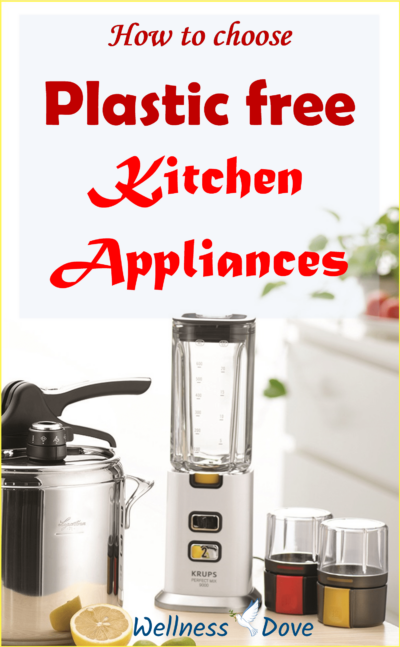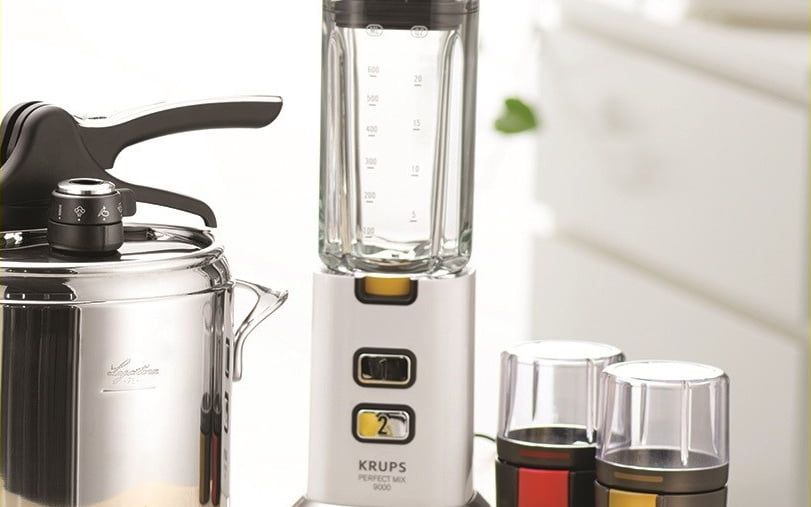
We’ve all heard that plastic is probably not the healthiest material to process and store our food in.
The thing is, though, that most kitchen appliances today are almost exclusively made from plastic.
And that begs the question: should you bother to look for plastic-free options or it’s not that important after all.
It all depends on the appliance and what are you gonna do with it.
Here’s how to choose.
Post Contents
The main considerations:
1. Are you gonna use it with hot food
Heat ages the plastic and makes it more prone to leach toxins into your food.
Basically, if you are going to cook in the appliance or use it with hot food, it is better to look for one made from natural materials such as glass or steel.
2. What kind of plastic is it made from
There is cheap plastic and there is high-quality plastic.
Many cheap appliances have their containers made from the toxic polystyrene type pf plastic (PS) that should be avoided. Better appliances use polypropylene (PP) plastic that is OK.
The high-quality appliances use BPA-free types of plastic (such as Tritan) that are unlikely to leach many toxins into the food, especially if you are not heating it.
1. Electric kettle
The electric kettle is probably the first appliance to get suspicious of.
A plastic kettle makes the water smell… of plastic.
Probably because many people find the smell so alarming, on the market today there is a myriad of choices for glass/metal kettles and their price has fallen to as little as $20.
When buying, though, look for any plastic parts inside, such as structural supports or parts of the handle.
That is why we do not recommend buying the cheapest kettle. Even when if on the photos you cannot see any plastic parts, in many cases, to insulate the space between the heater and the glass, synthetic silicon is used. It is placed directly next to the heater and is likely to leach toxins.
Our personal recommendation: Pohl Schmitt kettle. We have been using it for four years at least a couple of times a day and it is a great kettle.
Also, many high-end kettles are not made out of glass because plastic insulates better, which makes these models faster and more efficient. We believe, however, that health is far more important than efficiency or commodity.
Jug blender
It really depends on what you are going to do with the blender.
If you want to use it for hot food or have a smaller budget, it’s better to get a glass blender.
Obviously, heating plastic is not a great idea healthwise, so we prefer a simple glass blender. It doesn’t need to be super powerful for soups also.
Cheap plastic blenders are made from cheap plastic that will probably leach toxins so it’s better to go for glass.
High-power blenders are made from high-quality plastic only.
The thing is that powerful blenders are almost exclusively made from plastic but it’s BPA-free and quite resistant to leaching toxins.
Still, we avoid using them with hot food and we have one simple glass blender and one high-powered one.
Hand blender
Hand blenders should not be plastic.
You are probably going to use them with hot food and stainless steel options are widely available.
We would go for one with all-metal foot such as this Broun but swap the plastic beaker for a tempered glass one.
Mixer
Go for a mixer that has all-metal beaters.
For a countertop, choose one with an all-metal bowl as well as beaters.
Food processor
It’s almost impossible to find a glass food processor these days.
Still, since generally you don’t use your food processor with hot food you shouldn’t worry too much about it being made from plastic.
You can check our guide for choosing a food processor here.
Steam cooker
We believe that there should not be any plastic parts in a steam cooker.
Steam is an ideal medium to transfer toxins from the plastic walls and trays of the cooker into the food. Being hot and moist, it touches the plastic, easily absorbs the toxins. Then it circulates to touch and enter the food that is supposed to be cooked healthily.
Get a Steamer Pot. You can cook food on multiple levels and enjoy steamed food with the least chance of toxicity.
Get an Instantpot. It is made from steel, can steam your food and a ton of other stuff.
Juicer
Choosing a non-plastic juicer is quite a challenge.
There are only quite a few options available such as the Breville Die-Cast Juice Fountain Elite Juicer and the Angel Juicer.
However, do you actually need a non-plastic juicer?
Centrifugal (fast) juicers
When choosing a centrifugal juicer, we believe that it is important that the fast spinning parts (the ‘knife’) and the mesh are not plastic.
It is here, where the heat is generated and where your food is in greatest contact with the juicer.
The rest of the parts of the juicer only briefly touch the food and they could be plastic. Of course, you should check that these are safer types of plastic, such as SAN/AS.
A good example is this lower cost Breville Juice Fountain.
Slow Juicers
Slow juicers come in many sub-types and are generally plastic.
These juicers provide higher quality juice precisely because they do not create friction or heat your fruit and veg while juicing.
Hence, there is very little danger for toxins to leach into your juice. Simply go for a juicer that is BPA-free.
Our personal recommendation: the Omega VSJ843.
Coffee machine
We have phased out tea and coffee from our diet for a while now. We drink lemon water/fresh juice in the morning and an occasional afternoon green tea, which we prepare with our glass electric kettle.
As far as plastic is concerned, the water tank and all the tubing inside many of the coffee machines we know of, is made out of plastic.
It is alarming for us that hot water travels trough plastic tubes.
Inspect the inner tubing of the coffee machine before you buy it.
Also, check the materials the tubes are made out of. If you must buy a unit with plastic tubes, go for safer plastics such as PP (polypropylene).
Breadmaker
Our concern with bread makers is the non-stick coating – it should be PFOA free. Perfluorooctanoic acid is a known carcinogen that should be avoided.
Deep fryer, grill and sandwich maker:
These have been collecting dust in the cupboard for a while now. We have stopped using these as we went for healthier cooking methods such as steaming or simply oven-baking.
If we were to use a grill, we would go for ceramic coated instead of Teflon coated, as grills tend to reach high temperatures and the ceramic coating does not emit toxins at high temperatures as Teflon does.
There are all-metal, stainless steel grills also. However, they are notoriously hard to clean and the burnt food residue that is left on the grill is carcinogenic.
What are your considerations when using kitchen appliances?
Tell us in the comments below.




I know you said to buy a steamer pot, but I don’t have a kitchen or stove so can you tell me about an electric steamer that can steam like veggies and fish ect but has zero plastic in it, it also needs to be able to have easy access to the water reservoir for routine cleaning to prevent mold.
Thank you for your post! My Cuisinart food processor has a spring that popped out from inside the handle (where it latches). It went down the garbage disposal & I didn’t know it until it was too late. I’ve been trying to replace that spring & Cuisinart doesn’t sell it. Only the WHOLE jar assembly. I was hoping to replace it with glass instead of more plastic but I’m not seeing how this would be possible.
Just a comment on the coffee portion of your post: for coffee drinkers out there, there are several plastic-free options for making coffee besides the traditional drip-style maker. There are glass French presses, many pour-over options, as well as stainless steel espresso (stove-top) espresso makers. Sadly, I spent several hundreds of dollars on a high-end Rialto countertop cappuccino/espresso & it is almost completely made of plastic. That was something I didn’t consider back in the early 2000s when I had more dollars than sense. Even the milk pitcher & steam wand are made of plastic!!
Do you know of any larger appliances that can be 100% plastic free? I’m thinking about a fridge, stove, dishwasher. Everything I see seems to have plastic, is it truly unavoidable?
Hi,
All the larger appliances have plastic in them and I think it’s unavoidable since it will be very difficult for manufacturers to make their appliances from other materials in a cost-effective way.
Honestly, though, these appliances don’t come in direct contact with your food so there is less to worry about.
What I would recommend, though, is to choose more premium brands since they use less plastic and it’s of higher quality (and the appliances will last longer).
Cost-effective is not the only or most important consideration. Pay more, have a fridge (e.g.) for 40 years like we used to, and help reduce climate change. It’s not only about our own food storage and prep. Producing appliances that last 8-10 years if we’re lucky, is planned obsolescence. So self-destructive we are!
It seems you can no longer buy a stick blender without the stupid plastic jug!!??!!!
Hey Heather,
Yeah, it’s such a shame that they always include those plastic jugs that I simply don’t use! Vitamix make a nice immersion blender without any jug, though it’s quite expensive.
Vitamix has plastic in the food end…! Which surprised me.